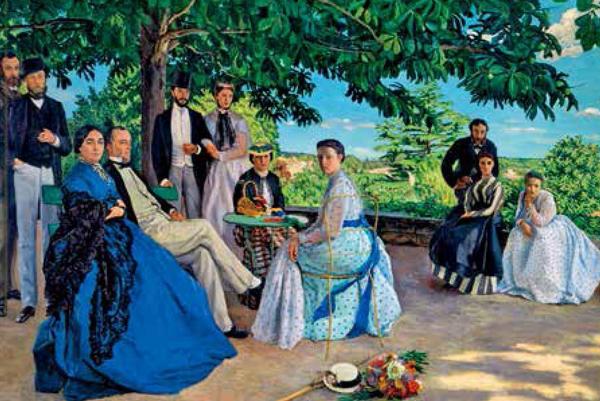寻找马尼拉披肩
2020-10-20蔡琴
蔡琴

广东省博物馆的员工食堂,是我喜欢的停留处,主要是因为透过落地的幕墙玻璃,可以欣赏人称“小蛮腰”的广州电视塔的光影变化。在鳞次栉比的高楼之间,结合展厅里曾经和正在举办的外销系列展览,仿佛可以辨析出阡陌水路,浮现当年世界各地从珠江口来到广州的千帆万桅。
为什么叫马尼拉披肩
广东地处南海之滨,海岸线绵长,良港众多。凭借便利的水陆交通、先进的造船技术、丰饶的物产资源和发达的手工业,广东早在秦汉时期就已成为海上丝绸之路的重要发祥地。
广东外销绸在全国丝绸出口中占有重要地位。外销绸,专指18世纪至19世纪前后,中国输出到世界各地特别是欧美的中国生产的丝绸织绣品。中国生产,一般指用的是中国的织绣技术;而所谓的外销,应该是指专为外销设计的图案和款式,有可能是完全西方的创意,也可能是带有东方影响的图案。而广绣大披肩,是中国外销品中重要的一宗,在西方被称为中国披肩或马尼拉披肩(mantn de Manila)。
我在中国丝绸博物馆任职期间,在赵丰馆长的支持、陈列保管部和技术部同事的协助下,对馆藏外销绸进行了整理和研究,2014年举办了展览和小型学术研讨会,成果汇编成《华美致远:中国丝绸博物馆馆藏外销绸珍品》一书。
广绣大披肩外销,一般先从中国东南沿海通过平底海船运到马尼拉,然后通过大帆船从马尼拉东跨太平洋,到达墨西哥的阿卡普尔科港;上岸之后,用大轮车运至大西洋西岸的韦拉克鲁斯港,再度装船,经大西洋至南欧的塞维利亚港,自此分发欧洲各地市场。
经几次转运之后,欧洲人只知大帆船上的货都来自集运港马尼拉,而不知原产地,因而称之为马尼拉大披肩。
马尼拉披肩在顺德
马尼拉披肩的起源目前无考。19世纪,巴黎开始成为时尚之都,擅长描绘室外场景和光影变幻的法国印象派画家,也随之开始在自己的作品中描绘那些时髦人士的着装,捕捉了各种场合的女性形象。从印象派画家的作品中可以看出,中国外销的披肩等配饰已经成为当时法国时尚生活的一个部分。安格尔、莫里索、雷诺阿、马奈、莫奈等著名印象派画家都曾画过相应的作品,女士们披着中国外销的披肩,或在包厢,或在花园,或在阳台,或执扇,或撑伞。
在200多年经久不衰的生产与发展历程中,马尼拉披肩在不同时代各具特色,从丝绸面料、线材、染料、配色、规格、流苏、构图、题材、风格到市场喜好等的变化中,既可以看到中西文化相互磨合和交融的过程,又能看出当时的社会历史文化背景。
中国丝绸博物馆藏黄缎地双面绣亭台楼阁披肩(约18世纪60至70年代)把镬耳屋这种建筑形式整合到画面里,作为戏曲故事的背景,构图匀称,色彩斑斓,极富装饰效果。
海贸重镇广州,包括沙面、黄埔等岛屿,都有这种叫镬耳屋的建筑形式。这种屋子用青砖、石柱、石板砌成,外墙壁均有花鸟图案。镬耳屋的山墙砌成镬耳状,故称镬耳屋。据说镬耳状的建筑,防火和通风性能良好:火灾时,高聳的山墙可阻止火势的蔓延和侵入;微风吹动时,山墙可阻挡风入巷道进而通过门、窗流入屋内。民间还有镬耳屋蕴含富贵吉祥、丰衣足食意义一说。
1865年之后,中国外销披肩尺幅更大,流苏和编结继续增长,直接可以当作包裹身体的衣服。中国丝绸博物馆藏黑色流苏披肩(20世纪初期)呈方形,以黑色重绉为地,以平绣针法用白色丝线绣制花卉,四角对称,构图细致繁密却又繁而不乱,四周辅以编织网格和长流苏。1926年出版的《西班牙区域服饰》中的一幅插图,与之几乎一模一样。
马尼拉披肩的魅力是和广绣的独特技艺分不开的。2019年1月,“风·尚——18至20世纪中国外销扇”展在广东省博物馆开展,在策展人白芳博士的陪同下,有幸考察了位于佛山顺德大良镇的广绣庄。大良,自古以来是顺德经济富庶之地,顺德的政治、经济、文化中心,商贾富人云集,“广绣重镇”“南国丝都”“广东银都”“粤菜之都”说的都是大良。当年大良的小船可以沿着大小河汊进入广州城,很多大良人都是在被誉为“第一码头”的大良码头坐船,途经伦教、勒流,然后直达广州南方大厦的钟楼。除承担客运功能外,“第一码头”还是个重要的货运码头,从广州、江门运来的货物,都是经“第一码头”运到大良,而大良的农副产品、手工艺品等,也是通过这个码头运往各地。显然,这个水网联系起了广阔的世界,使大良成为世界的一部分。
今天的大良华盖路步行街两旁,还保留有明末清初骑楼特色的岭南西洋建筑,在古码头,还依稀可见当年“第一码头”的风貌,不过整体上大良已经成为一个观光型的城镇。在华盖路的显著位置上,有8层楼高的广绣大厦,代表了顺德广绣曾经的繁华。如今这座旧楼略显破败,但仍有一批经营者和刺绣从业者坚持守卫着广绣的记忆,把自己编织进跨海的网络,一边传承着传统,一边根据市场变化创新设计,制作了一批新版披肩,把广绣运作至今。由于现代化进程,绣工大量流失。从20世纪80年代初开始,顺德刺绣工艺总厂便开始往潮汕、茂名等地区发展广绣生产基地,之后又往江西、湖南、广西等地扩建广绣生产基地,同时开拓国内市场,以前百分之百外销的产品,如今内销已经占据了产量的近3成。
马尼拉披肩在秘鲁
2019年12月,我旅行来到秘鲁东南部的普诺——坐落于世界上海拔最高的可承载航运的湖泊的的喀喀湖岸边——使我对马尼拉披肩的现状,得以有了更全面和深入的认识。
普诺是印第安克丘亚族和艾马拉族人的故乡,城市历史悠久。最著名的普诺大教堂,位于普诺中心的武器广场(Plaza de Armas),建于17世纪。由于正在维修,游客只能在围挡外观赏。同时,我偶尔发现写有“CHIFA”的中餐馆。“CHIFA”是粤语“吃饭”的谐音,这是秘鲁中餐馆特有的招牌,已经被收入当地词典,成为秘鲁中餐馆的专有名称。炒饭和云吞又是“CHIFA”的招牌菜,而炒饭和云吞这两个词在西班牙语里面,也是由粤语直译过来的。除了“CHIFA”、炒饭、云吞等词语直接沿用粤语发音,在秘鲁,当地人也直接把“姜”叫做“kion”、酱油叫做“sillao”、白菜叫做“bok choy”,这些都来源于粤语。
“馬尼拉大帆船贸易”带来的中国商品,对拉丁美洲各地也产生了一定影响。在当时西属美洲殖民地的上层社会中,女士以穿着中国丝绸为时尚,看起来几乎是同一时期在欧洲流行的“中国热”的翻版。
离开普诺的前一天傍晚,在皮诺广场(Pino Park)的圣母圣殿教堂(Santuario de la Virgen de la Candelaria)前,我幸运地遇见了狂欢的游行队伍。宗教节日、印第安传统节日、民族独立日或建城周年,大家都会游行庆祝。
游行的队伍款款过来,每人都手拿沙槌和花束,随着鼓乐缓缓前进。一个方阵为一个团队,统一着装。一个方阵接一个方阵,男队女队间隔行进。男士方阵穿西装,女士方阵穿印加民族服饰anacu改良过来的有着鲜艳的色彩和多层次的宽大蛋糕裙,而最吸引眼球的是她们的披肩。
披肩的颜色与方阵衣服的颜色统一,流苏目测长达40多厘米。随着舞步和手中装饰绚丽的沙槌的摇动,流苏甩开来,极富动感,让人联想起西班牙弗莱明戈舞的热烈奔放以及演员身上那飘逸的大披肩。只是,披肩再也不是精工而奢华的广绣,而是更加适合快餐文化的机器生产的舞蹈用品。可见,曾经通过“马尼拉大帆船”为中南美洲带来大批商品的中国,在今天依然能够以开放的姿态与拉美各国开展贸易。
我沿着利马街,在观看游行的人群中穿梭。
我在寻找马尼拉披肩。
Viewed from the canteen of Guangdong Provincial Museum, the Canton Tower, the landmark of Guangzhou, is a spectacular view of pattern of lights dancing over the glistening skylines of the sleepless city. The museums exhibits interact with the charming urban views set against a network of waterways ushering a thousand sails into the estuary of the Pearl River.
Genesis of the misnomer
Situated at the meandering shores of the port-studded South China Sea, Guangdong became a key seedbed of the “Silk Road on the Sea” in as early as the Qin (221-207BC) and Han (206BC-220AD) times of China. The cornucopia produced a vibrant scene of ship-building and handicraft industry.
The provinces silk export, with a history beginning at the turning point of the 18th Century and 19th Century, has long been a major player in Chinas silk trade. A special category of the high-quality, tailor-made silk products exported to the Western clientele, often referred to as “mantón de Manila” or “mantón de China”, was a Guangdong specialty. The shipping routes normally stretched from several stopovers on the Pacific Ocean to Mexico and then went from the western coast to the eastern coast of the continent all the way to the west bank of the Atlantic Ocean. The sea routes crossed the Atlantic and reached Europe. With little knowledge of the origin of the beautiful fabric, some Europeans unthinkingly and therefore mistakenly took Manila, the first transfer port of the goods from Guangdong, as the source area of the silk wraps, hence the misnomer.
An exhibition and a small-scale academic symposium, based on my research about the silk export of China, held in 2014, led to the release of a book titled .
"Mantón de Manila" in Shunde
Silk wraps and many other accessories became very much sought-after in France in the 19th century when Paris rose to be the “fashion capital” of not only the country but also the greater Europe. The luxurious beauty of the Oriental silk fabric is portrayed by many Impressionists such as Renoir and Monet in their works depicting the leisure life of upper-class Parisian courtesans.
Throughout its history of more than 200 years, the quality and design of “mantón de Manila” varied with times, presenting interesting facts of East-West communication in different social contexts.
Made in the 1860-70s, one of the exhibits at the China Silk Museum in Hangzhou shows the intriguing innovation of a Southern China architectural feature integrated into the pattern design to create a luxuriant, colorful aesthetic effect. Colloquially known as “Cauldron-Ear House”, this special gable wall style is crafted to make the structure fireproof and well-ventilated, with the decorative details suggesting auspicious implications.
A distinct change of the design of “mantón de Manila” came in the mid 1860s, as can be seen from some exhibits that feature a much bigger width of the fabric and noticeably longer tassels.
The key part of the enduring charm of “mantón de Manila” is the unique artistry of whats known as Guangdong embroidery. People today can admire the handicraft in the historical town of Daliang, where the towns former glory and long-time opulence can be seen from the relics of ancient docks and ravishing architecture flanking the Huagai Road. Since ancient times, the town has been the most vibrant economy of Shunde, Foshan City. The eight-storey Guangzhou Embroidery Building that stands at an outstanding spot of the pedestrian road is a symbol of the towns former embroidery glory.
"Mantón de Manila" in Peru
A visit to Puno, a historic town seated on the shores of Lake Titicaca, in the winter of 2019, refreshed my understanding of “mantón de Manila”. At 3,800 meters above sea level, Lake Titicaca is the highest navigable body of water in the world.
The hometown of Quechuans and Aymara Indians, Puno draws in tourists for a host of historical spots represented by Plaza de Armas, built in the 17th century. The towns trade and cultural communication with Guangdong can be told from many loanwords such as “chifa” (meaning “Chinese restaurant”), “kion” (meaning “ginger”), “sillao” (meaning “soy sauce”) and “bok choy” (meaning “Chinese cabbage”), all from the Cantonese dialect.
On the night before I left Puno, I came across a celebrative procession right in front of Santuario de la Virgen de la Candelaria at Pino Park. The wraps on the girls, all dressed up in colorful layered cake-style dresses, instantly caught my eye. The tassels danced wildly in the air, making me immersed in the fierce passion of Flamenco. Although the wraps used by the dancers were obviously not the fine silk fabric that once enchanted the upper-class Parisians, I knew the connection between east and west was there and would be there for many more centuries to come. And I knew my adventure of “mantón de Manila” would continue.
